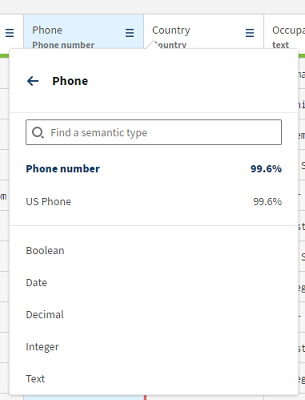Enriching the semantic types libraries
If the semantic type proposed by Talend Data Preparation for one column is not the desired one, you can manually change it by clicking the menu icon in the column header.

This allows you to choose among the list of semantic types present in Talend Data Preparation by default. See Predefined Semantic Types for more information. You can go further by creating your own semantic types, as well as updating or deleting the existing ones, so that Talend Data Preparation speaks your business language.
The semantic types modifications are made directly in the Talend Data Preparation interface, via the Semantic types tab of the left menu. All the changes are stored using Talend Dictionary Service and are propagated across various Talend products.
The availability of Talend Dictionary Service depends on the license you have.
- The DICT type, based on an open or closed list of values.
- The REGEX type that compares your data against a preselected regular expression.
- The COMPOUND type, under which you can group several existing types.
To enable the interaction between Talend Dictionary Service and Talend Data Preparation, you must fulfill the following prerequisites:
- You have a Platform license.
- YourTalend Cloud user must have the Semantic types manager role of the Dictionary service application assigned in Talend Management Console, in addtion to any of the Talend Cloud Data Preparation roles.
Did this page help you?
If you find any issues with this page or its content – a typo, a missing step, or a technical error – let us know how we can improve!
